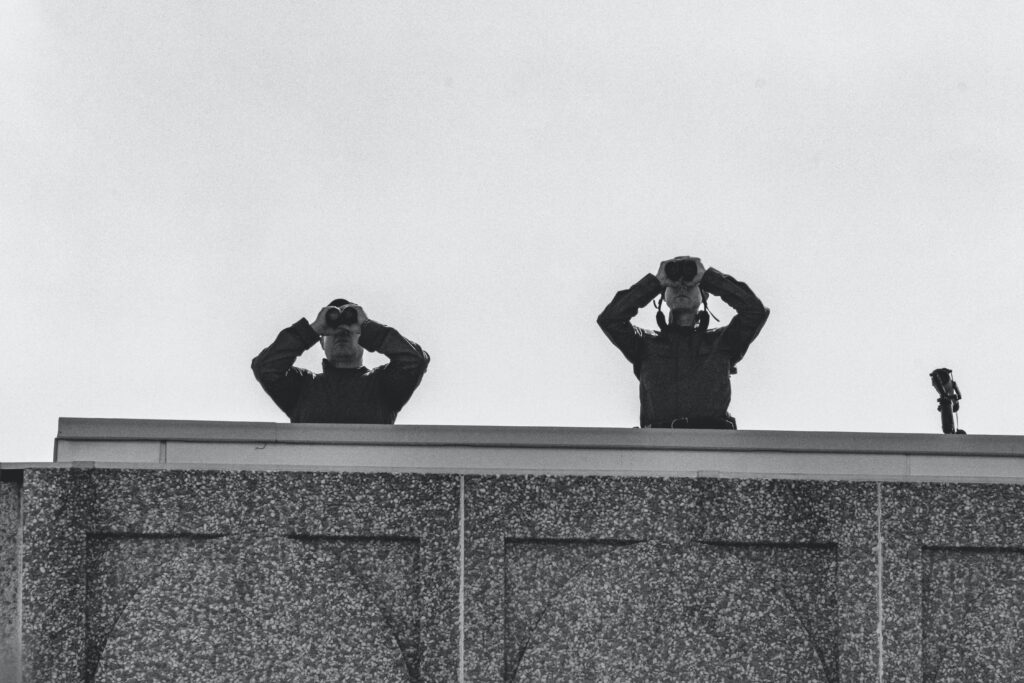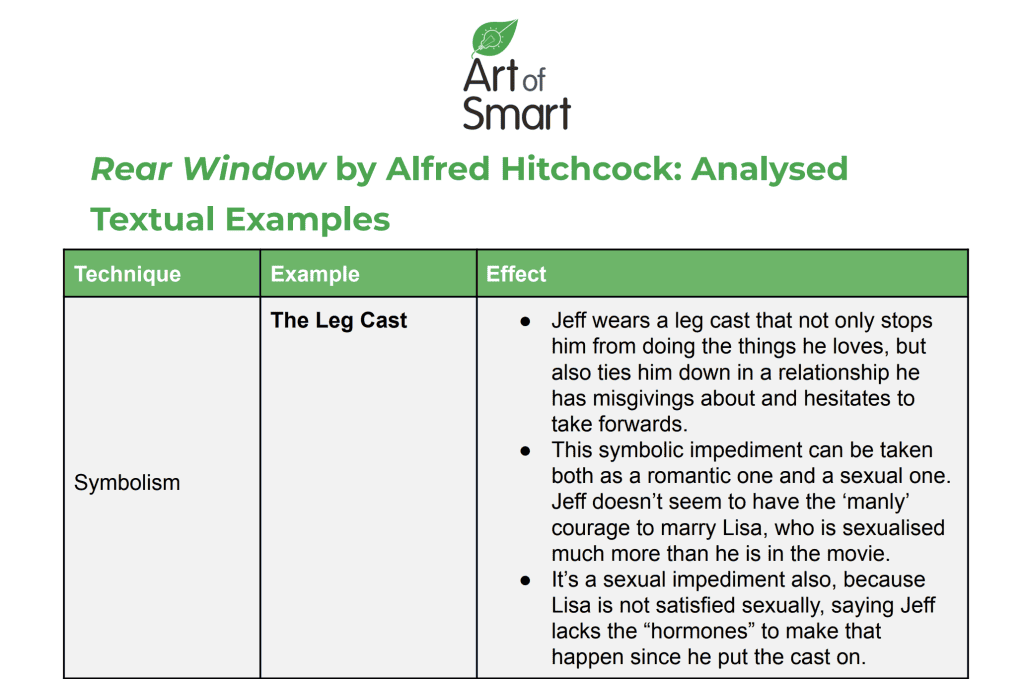Coming up with your analysis for ‘Rear Window’ by Alfred Hitchcock?
You’ve come to the right place! Here is a summary of ‘Rear Window’, along with its key themes and a step-by-step guide on how to break down and ace your text analysis.
We also threw in a FREE sample analysis table (also known as a TEE table) and a sample paragraph for you!
So, let’s go and vamp up your essay!
Summary of Rear Window by Alfred Hitchcock
Key Characters
Context
Themes Explored in Rear Window
Analysis of Rear Window by Alfred Hitchcock
Summary of Rear Window by Alfred Hitchcock
Alfred Hitchcock’s masterpiece begins with the protagonist, a talented photographer L.B. “Jeff” Jefferies, breaking his leg and being relegated to his apartment by the injury.
He hates being stuck in the situation, and resolves to spy on his neighbours to entertain himself. His neighbours keep open windows due to the hot summer weather. What makes the situation unbearable is his beautiful and dependent girlfriend Lisa, who is very clingy.
Among the group of neighbours he is spying on, one night he notices Mr Thorwald, a businessman married to a bed-ridden grumpy woman, walking in and out of the apartment with his case, after the mysterious scream of a woman.
When Jeff learns Thorwald’s wife has been murdered, he suspects the husband of murder.
He becomes obsessed and persists spying on the businessman, convincing both Lisa and Stella, his nurse, that Thorwald is guilty.
Detective Lt. Doyle, a policeman and friend to Jeff, is called to the scene, and dismisses his friend’s theories.
A dead dog is then found buried in a flowerbed, a fact that further consolidates Jeff’s theory, as Thorwald seems unflinching and unbothered by the discovery, unlike everyone else in the neighbourhood.
Want to walk into your end of year English exam with confidence? Check out our tips here!
Jeff baits the businessman into leaving his apartment by anonymously phoning him and sending him a letter, threatening to tell everything to the police.
Lisa is then sent to the apartment to search for clues, finding Thorwald’s wife’s wedding ring.
The businessman returns, however not before the police have arrived too in the nick of time. Lisa signals Jeff that she has found the ring by wiggling her finger, a sign that Thorwald interprets too, unfortunately.
The businessman pays a visit to Jeff with the intention of killing him, pushing him out of a window. He survives, and the police manage to catch Thorwald. It ends with Jeff having two legs broken instead of one.
Doyle admits Jeff was right.
Lisa keeps Jeff company, glad she has proven to Jeff that she isn’t just a useless pretty hassle, as she was instrumental in finding the evidence to convict Thorwald.
The movie is a much less gruesome affair than the usual Hitchcock, but nevertheless it still carries an edge to it.
Key Characters
Jeff
There are three aspects to understand about the protagonist.
The first being his love of adventure. Given his background as an on-site photographer, he enjoys being called to remote or dangerous parts of the world to do photojournalism.
He craves adventure and travel. This is one of the reasons why he struggles so much when he must stay put in his apartment for recovery.
The second aspect is his relationship with Lisa. Given his love of adventure, a clever, beautiful and dependent woman like Lisa who wants to marry and settle down is a big red flag for him, as he may lose all his freedom by settling down in a committed relationship.
On top of that Lisa is very clingy, which only strengthens his doubts as to whether he should settle down and spend his entire life with her.
Thirdly, his background in Journalism makes him the perfect detective, and the perfect medium of communication between the audiences and the other characters. He raises the same points we would and asks the same questions as if we were there with him, or as if we were him.
Lisa
Being a fashion model paid her weight in gold, Lisa is the polar opposite of Jeff, at least on the surface.
Jeff thinks she is not made for the adventurous life he leads.
Hence they are divided. She tries to distract Jeff from the investigation, but gets drawn in, and proves that she is as forward and adventurous as him by putting her life at risk and trying to gather evidence at Thorwald’s apartment.
Lisa is the victim of many misogynistic stereotypes common at the time of the film.
She is misunderstood by her male partner and dismissed, like many minor female characters in the movie. This misunderstanding collapses as the movie is resolved.
Thorwald
It is extremely telling that the villain of the movie is seen so little, and speaks so little in the entire film. Everything the audience experiences about Thorwald is through Jeff’s eyes, it is his perspective, his account.
This ensures audiences see Thorwald as if they themselves were in Jeff’s apartment, observing. It also serves to keep the businessman mysterious, except for his disclosed unhappiness in the marriage and his peculiar comings and goings.
Further, the simplicity of his context and his life humanises him, and doesn’t dismiss him as just a grand, theatrical villain.
His life is so mundane, normal and unhappy, that he resolves to murder to escape it.
This gives audiences some form of sympathy towards him, a feeling Hitchcock demands in all his works when it comes to villains.
Stella
Stella is a nurse that attends to Jeff as he recovers.
In terms of storyline, you can think of her as the sidekick or comic relief of the movie.
In her droning on about love, marriage and the reality of it, she provides comic relief during tense moments, but also serves as a bridge between Jeff and Lisa, suggesting to Jeff they should get married, and explaining the difficult reality of a relationship.
Context
A cross between a thriller, a romance, and a comedy, Rear Window is a perfect reflection of American life in the 1950s.
Domesticity was becoming more and more established, especially after a decade of war, and people had to come to terms with the dynamics of at home life, a quiet life that had been so removed in the previous decade.
This is hence why Hitchcock pries into the apartments of different people with different struggles. Individual desires and struggles could no longer be put aside to participate in something ‘bigger’ than individual life, like a world war.
People had to re-learn how to figure out their relationship problems and home dynamics after facing economic and social hardships of the past decade — Jeff is an example of such a learning curve.
Themes Explored in Rear Window
Dissatisfaction
All main characters are dissatisfied with their situation. The murderer can’t stand his wife due to her nagging him and being sick all the time. Jeff also can’t stand Lisa because she intimidates him and she’s too different to him in his mind.
These circumstances set up the central conflict that the movie is about.
So what makes Jeff different from Thorwald if they find themselves in the same situation? It is how they deal with dissatisfaction.
Jeff comes to terms with it, tries to work through it with some help from Stella and Lisa, while Thorwald resolves to murder.
This theme is so central because it reveals the fundamental difference between hero and villain in the story, and because it is responsible for setting up the central conflict of the movie.
Perseverance
As we have concluded, the resolution of dissatisfaction comes with perseverance. Characters are rewarded for it.
Jeff perseveres with both his relationship and investigation, a fact that saves both things by the very end. He does this with some hesitation at first, but he is sweetly rewarded after.
Hitchcock also gives us an example of what happens when perseverance and dialogue are thrown out of the window. Literally. Thorwald has no patience, and he suffers the consequences morally and later materially when he is arrested.
How to Analyse Rear Window in 3 Steps
Step 1: Choose your example
The best way to choose an example is to choose a technique.
Remember you must include stylistic devices (how images and words are arranged in a text in order to produce meaning), and aesthetic features (elements that prompt a critical response from the reader) in your essays to gain the most marks.
In this case, we will use the quotes:
“If you don’t pull me out of this swamp… I’m going to get married. Then I’ll never be able to go anywhere”
“If she was only ordinary.”
Step 2: Identify your technique(s)
To highlight dissatisfaction within Jeff, Hitchcock employs metaphor and characterisation.
The audience has to realise Jeff cannot come to terms with the fact that his lover is more successful than him and, on the surface, less adventurous.
He thus sees her as an impediment rather than a partner. This is what these two quotes reveal.
Step 3: Write the analysis
Always be ready to ask yourself what the author intended you to feel/respond emotionally by reading the example quote.
This will make sure that you tackle an important part of the analysis for Rear Window, which is the effect on the reader.
Alfred Hitchcock employs both metaphor and characterisation to identify dissatisfaction and mistrust in his protagonist, Jeff, revealing his most compromising flaws at the beginning of the movie. In his remarks to his employer, “If you don’t pull me out of this swamp… I’m going to get married. Then I’ll never be able to go anywhere”,This highlights a deep divide between the two, and we are thus drawn in to observe not only the investigation dynamic, but how the protagonist will navigate this situation of self doubt.
Need some help analysing other texts?
Check out other texts we’ve created guides for below:
- ‘Red’ by Ted Hughes
- Like a House on Fire
- Amélie
- Howl’s Moving Castle
- King Lear
- After Darkness
- One Flew Over the Cuckoo’s Nest
- Fever 103
- I Felt a Funeral in a Brain
- Journey of the Magi
- Shafana and Aunt Sarinnah
- Rhapsody on a Windy Night
- Frank Hurley: The Man Who Made History
- Mabo
- Rainbow’s End
Are you looking for some extra help with your analysis of Rear Window by Alfred Hitchcock?
We have an incredible team of English tutors and mentors!
We can help you master your analysis of Rear Window by taking you through the summary, context and themes. We’ll also help you ace your upcoming English assessments with personalised lessons conducted one-on-one in your home or online!
If you’re studying this text for the VCE and need some tailored support, our Melbourne English tutors are here to help.
We’ve supported over 8,000 students over the last 11 years, and on average our students score mark improvements of over 20%!
Give us a ring on 1300 267 888, email us at [email protected] or check us out on TikTok!
Vittorio Manessi is an Art of Smart tutor based in Queensland studying environmental science. He was one of the first Year 12 students to study under the new ATAR system in Queensland. He enjoys Maths, Science, English and Ancient History and is keen to share his knowledge of the QCE by making awesome resources.







